The demand for fresh meat delivered directly to doorsteps is rising across the globe. Whether it’s busy professionals, health-conscious families, or urban dwellers with limited access to quality butchers, more people now prefer buying meat online. If you are planning to tap into this growing market, the key lies in leveraging the right technology, particularly through meat ordering app development.
Having a food-based business is when you need to gauge the maximum audience so that you can flourish. A business well set is nothing until backed with awesome backup street smart marketing. The options one has is to create an online food delivery app. The first option to have it is to find a reliable company, which has expertise in creating an online food delivery app.
Building a meat delivery business is not just about sourcing meat and managing logistics. Today, success heavily depends on creating a seamless, user-friendly, and scalable digital platform that connects local meat vendors with customers.
In this blog, we’ll walk you through everything you need to know to build and launch a meat delivery app—from business planning and app features to tech stack and marketing strategies.
Why Should You Build a Meat Ordering App?
The global online meat delivery market is projected to grow at a 10% CAGR through 2030, driven by convenience and quality demands. A dedicated app positions your business to capitalize on this trend. Here’s why meat ordering app development is a must:
- Seamless Customer Experience: Offer 24/7 ordering, detailed product descriptions, and real-time delivery tracking.
- Operational Efficiency: Automate inventory, order processing, and logistics to reduce errors and save time.
- Brand Loyalty: Personalized offers and subscription plans keep customers coming back.
- Scalability: Reach new markets without the overhead of physical stores.
With Deonde’s SaaS-based meat delivery solutions, you can launch a branded app quickly tailored to your business needs. Investing in an app isn’t just about technology; it’s about building a modern, customer-centric meat delivery empire.
How a meat ordering app helps you?
There are a number of things which Food Delivery App Development companies can help you with, however the one which we are focusing upon is a meat ordering app.
Ordering a meat online delivery app can boost your sales, other than enhancing your reach to netizens.
Usually, there are several customers who shy from buying by walking into a meat shop.
For them, the simplest solution to buy meat is to order through an online food delivery app for ordering meat.
Step-by-Step Guide to Launching a online Meat Delivery Business

1. Conduct Market Research
Thorough market research is essential to understanding the landscape and identifying opportunities in the meat delivery business. Start by analyzing the competitive environment to see what other meat delivery services are operating in your target area. Study their business models, pricing strategies, product offerings, and customer feedback to identify gaps in the market.
For insights, check Licious’s business model.
Next, define your target audience by demographics, preferences, and behaviors. Are you targeting busy professionals who value convenience, health-conscious consumers seeking organic options, or perhaps meat enthusiasts looking for premium cuts? Understanding your audience will shape everything from your product selection to your marketing approach.
Also, research meat suppliers in your region to ensure you can source quality products consistently. Evaluate their reputation, pricing, delivery reliability, and compliance with food safety standards. Building strong relationships with reliable suppliers is crucial for your business success.
2. Define Your Business Model
With your market research as a foundation, it’s time to define your business model. Will you operate as a marketplace connecting consumers with multiple meat vendors, or will you maintain your own inventory and fulfill orders directly? Each approach has different implications for operational complexity, capital requirements, and scalability.
Consider your pricing strategy carefully. Will you compete on price, quality, variety, or some combination? Factor in all costs including procurement, storage, delivery, app maintenance, and marketing when setting your prices to ensure profitability.
Determine your delivery radius and schedule based on logistical capabilities and customer expectations. Some meat delivery businesses offer same-day delivery within a limited area, while others provide scheduled deliveries with wider coverage. Your delivery model should balance customer convenience with operational feasibility.
3. Plan App Features
With your business model defined, you can now plan the specific features of your meat ordering app. Beyond the essential features mentioned earlier, consider adding:
- Detailed product information including cuts, weight options, cooking suggestions, and nutritional information
- Personalized recommendations based on purchase history
- Easy reordering of previous purchases
- Special dietary filters (halal, kosher, organic, grass-fed, etc.)
- Flexible delivery scheduling options
- Customer support chat integration
Prioritize features based on customer value and development complexity to create a roadmap for your app development. Remember that it’s better to launch with a solid core functionality and add features over time based on user feedback.
4. Partner with a Development Team
Unless you have strong technical expertise in-house, you’ll need to partner with a development team to bring your app vision to life. When selecting a development partner, consider the following:
- Experience in food delivery app development
- Portfolio of successful projects in the e-commerce space
- Technical expertise in both iOS and Android platforms
- Understanding of UX/UI design principles
- Knowledge of payment gateway integration and security
- Ability to implement real-time tracking features
- Support and maintenance capabilities
The development process typically involves several stages including discovery, design, development, testing, and deployment. Establish clear milestones, deliverables, and communication channels to keep the project on track.
A Saas-based solution like Deonde’s meat delivery app can significantly reduce development time and costs for businesses looking to accelerate their market entry. Such solutions offer customizable, ready-to-deploy applications with all the essential features already built in, allowing you to launch your business in weeks rather than months.
5. Ensure Compliance
The meat industry is subject to strict regulations to ensure food safety and consumer protection. Before launching your business, ensure compliance with all relevant health and safety regulations, including:
- Food safety certifications for storage and handling of meat products
- Temperature control requirements during transportation
- Proper packaging guidelines
- Labeling requirements including origin, weight, and use-by dates
- Business licenses and permits specific to food delivery
- Data protection regulations for handling customer information
Working with legal experts familiar with food industry regulations can help navigate this complex landscape and avoid costly compliance issues down the road.
6. Test and Launch
Before full-scale launch, conduct thorough testing of both your app and operational processes. Key areas to test include:
- App functionality across different devices and operating systems
- Payment processing and security
- Order flow from placement to delivery
- Inventory synchronization
- Delivery logistics and tracking accuracy
- Customer support processes
Consider launching a beta version to a limited audience to gather real-world feedback and identify any issues before your official launch. This approach allows you to refine your offering based on actual user experience.
When you’re ready to launch, prepare a comprehensive marketing strategy to generate awareness and drive initial downloads. Utilize social media, content marketing, influencer partnerships, and promotional offers to create buzz around your new service.
7. Market Your App
Post-launch marketing is crucial for growing your customer base and establishing your brand in the market. Develop a multi-channel marketing strategy that includes:
- Social media campaigns showcasing your meat products and satisfied customers
- Email marketing to nurture prospects and engage existing customers
- Content marketing focusing on meat selection tips, cooking guides, and recipes
- Referral programs incentivizing customers to invite friends and family
- Partnerships with complementary businesses such as wine shops or cooking equipment retailers
- Targeted advertising on platforms frequented by your ideal customers
Track the performance of your marketing efforts and adjust your strategy based on data to maximize ROI. Use in-app analytics to understand customer behavior and refine your user experience and product offerings accordingly.
Must-Have Features for a Meat Ordering App

To create a successful meat delivery app like licious , you need to incorporate key features that enhance the user experience, streamline operations, and drive customer satisfaction. Here are the essential features your meat ordering app should include:
Intuitive User Interface
Any food delivery app needs a user-friendly and clean interface. Your app should include easy navigation and a simple ordering process with prominent product categories. Clear, high-quality images of products with comprehensive product descriptions assist users in purchasing products confidently. It should also be visually appealing, with a scheme of colors that complements food and creates hunger.
Real-Time Inventory Management
One of the largest challenges in the meat delivery business is inventory management. Your app should give instant information concerning available products, quantities, and variants to avoid overselling and customer frustration. This information should be synced with the inventory management system to instantly update product specifics as demand comes in.
Secure Payment Gateway
Security is of the utmost importance when it comes to online payments. To give your customers flexibility, offer multiple payment methods, such as credit/debit cards, digital wallets, and cash on delivery. Use a payment gateway that is PCI-DSS compliant and applies encryption to secure customer financial data. Displaying security badges can also build confidence among cautious consumers.
Delivery and Tracking Updates
Transparency throughout the delivery process also maximizes customer satisfaction. so that customers can track their order from preparation to delivery. Push alerts at critical points (order confirmation, preparation, dispatch, and delivery) also keep the customer in the loop during the process. For perishable products such as meat products, handled with extra care, temperature indicators can also give extra confidence in the product’s quality.
Subscription Plans
Repetitive orders are a great source of constant income for meat delivery businesses. Introduce subscription plans that enable users to arrange weekly or monthlong delivery of their most purchased meat products. Reward subscription users with discounts and special perks to attract them to the subscription plan. Make subscription information easy to manage to include frequency of delivery, quantity of delivery and delivery preferences.
Push Notification
Strong communication is important to keeping the customer engaged. Send push alerts to notify the customer of newly arrived products, promotions, and delivery schedule alteration information. Personalized alerts based on past purchases can drive higher conversions. Be mindful not to bombard users with excess alerts, which may result in app removal.
Ratings and Customer Reviews
Widely accepted by humans, purchasing decisions are largely influenced by social proof. Let customers give ratings and reviews of products that they purchased to guide other buyers in their decisions. Use average ratings and reviews on product pages to establish trust with new buyers. Use a mechanism to ensure reviews from actual buyers to enhance authenticity.
Loyalty Programs
Customer retention is usually cheaper than acquisition. Create a loyalty program that gives frequent buyers points, discounts, or special offers. Make it game-like with achievement levels or badges according to various purchase milestones. Make rewards easy to see and achieve so buyers remain encouraged to order repeatedly.
Discover restaurant loyalty program examples.
Some Additional Must-Have Features for a Meat Ordering App
Manage multiple Stores at once
According to the traditional approach, if you are running multiple branches under your brand name, a person needs to be dedicated, especially those who can manage a branch.
Designating an outsider means adding into salary expense while on the other hand it can be managed only if the business owner hops from one place to another.
All this becomes very tough and tiring. An online meat delivery app helps you to stay relaxed and manage multiple stores at once.
Can control your customer database
Sensing a slump in your business? Send a reminder through the app to frequent buyers with latest images. Doing this converts leads into sales, boosting overall profit for your business.
Conclusion
Launching a meat delivery business with meat ordering app development is your ticket to success in 2025’s booming market. A custom app streamlines operations, delights customers, and scales your brand to new heights. With SaaS-based meat delivery solutions, you can launch a feature-rich, branded app quickly and affordably.
Start with thorough market research, build an app with must-have features like subscriptions and order tracking, and market aggressively to build a loyal customer base. Overcome challenges with Deonde’s tools, from third-party integrations to analytics. Ready to deliver fresh, high-quality meat to doorsteps? Get started with Deonde today and tap into the growing demand for convenient meat delivery!
Also Read:




